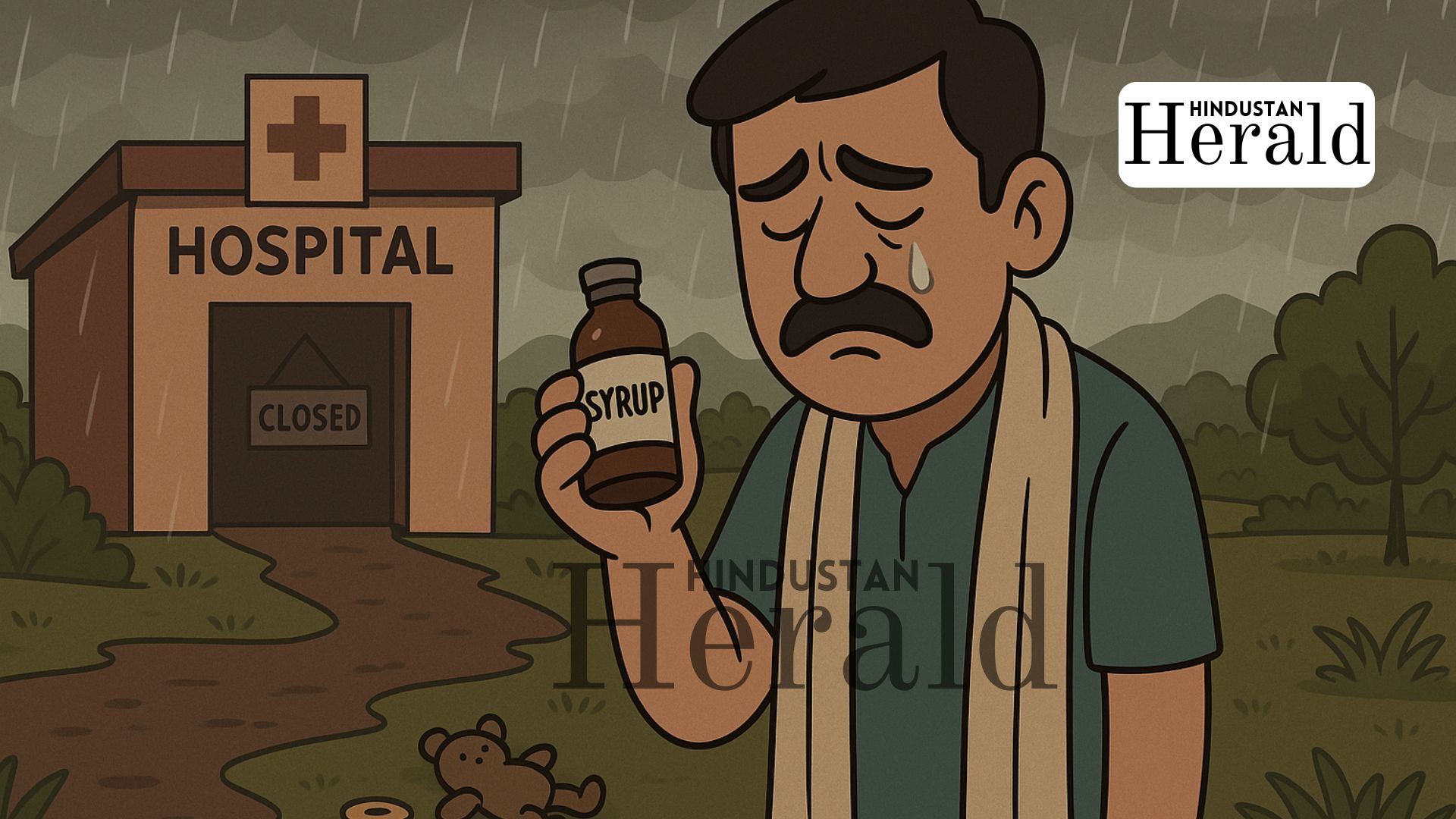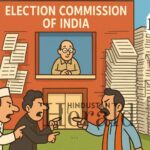Bhopal, October 11: It began like any other monsoon afternoon in Parasia, a small tehsil tucked inside Chhindwara district, Madhya Pradesh. The rains were steady, the roads muddy, and the coughs and fevers going around felt routine, nothing parents hadn’t seen before.
A local doctor wrote out a prescription: 4 ml of Coldrif syrup, four times a day. A simple instruction to treat a child’s cold. A week later, the same parents were running between hospitals, watching their children vomit, their kidneys fail, and their small bodies slip away.
By the time officials realised what was happening, it was too late. At least 17 children were gone. Some say 20. All from the same bottle.
A Medicine That Wasn’t Medicine
Coldrif was made by Srisan Pharmaceuticals, a licensed company in Kanchipuram, Tamil Nadu. It was approved, packaged, and sold legally in India. But when the samples were tested, what came out of the lab looked less like a cough syrup and more like industrial waste.
The syrup contained 48.6 percent diethylene glycol (DEG), a chemical used in brake fluid and antifreeze. The legal limit is 0.1 percent. To put it simply, the children weren’t overdosing; they were poisoned.
Parents in Parasia had no idea. They kept giving the syrup on schedule, trusting their doctor, trusting the system. By the time the first reports surfaced, hospitals in Chhindwara and Nagpur were full of children with failing kidneys.
One father, Mahesh, said his three-year-old daughter Vidhi was his only child. “She just had a cough,” he told reporters. “We did what the doctor said. But then she couldn’t pass urine. We took her to Nagpur, then to Bhopal. Nothing worked.”
Another father, Prakash Yaduvanshi, sold his fields and spent ₹7 lakh trying to save his son. “Dozens of children were dying,” he said. “The administration did nothing. Government hospitals are useless. The poor have nowhere to go.”
The Factory Of Death
When officials finally raided Srisan Pharmaceuticals, the findings were stomach-turning. Rusted pipes. Chemical residue on plastic tubes. No quality control chemist in sight. Workers mix ingredients with their bare hands.
The most damning revelation was about the syrup’s raw material, propylene glycol. It’s supposed to be pharmaceutical grade, but Srisan allegedly sourced industrial-grade supplies without proper paperwork. In other words, what should have been medicine was made with the same solvent used to clean engines.
The fatal batch, marked SR-13, had DEG levels five hundred times higher than what’s legally permitted. Tamil Nadu’s regulators tested it and banned it within 36 hours. Madhya Pradesh’s authorities, though, took nine days to confirm the results. Those nine days cost lives.
When The State Looked Away
The Madhya Pradesh health department insists it acted “as soon as possible.” But the timeline tells another story. Parents were still being told to continue Coldrif doses while samples were lying untested in government labs.
And when outrage finally reached the headlines, the state’s first big move wasn’t against the factory, it was against the doctor who prescribed the syrup.
Dr. Praveen Soni, a pediatrician who’s been practicing in Parasia for years, was arrested and charged with negligence. The logic: he prescribed a medicine that killed children. The Indian Academy of Paediatrics called it what it was scapegoating. “You can’t blame a doctor for trusting a legally approved drug,” one senior IAP member said.
While Dr. Soni sat in custody, the factory owner, G. Ranganathan, was still being “questioned.” Only later, after nationwide outrage, was he arrested reportedly heckled by angry families as he was taken to Nagpur.
A Familiar Pattern
If the story sounds disturbingly familiar, that’s because it is. In 2022, 66 children in The Gambia died after consuming contaminated cough syrups made by another Indian firm. Similar tragedies have unfolded in Uzbekistan, Cameroon, and Indonesia all linked to Indian drug exports containing diethylene glycol or its cousin, ethylene glycol.
After Gambia, India promised reform. The government announced tighter export checks, “stricter standards,” and a review of manufacturing units. Yet here we are, a domestic repeat of the same failure, only this time the victims are Indian children.
The Cost Of A System On Paper
India’s Central Drugs Standard Control Organisation (CDSCO) is supposed to test every batch of medicine produced and sold. But the Coldrif case shows what insiders have said for years: on paper, our drug control system is strong; in reality, it’s hollow.
The country has one drug inspector for every 250 manufacturing units, and testing facilities are chronically underfunded. The few inspectors who do file reports are often ignored or, worse, transferred.
Experts say even after the Gambia scandal, there was no nationwide recall mechanism, no database for bad batches, and no independent lab monitoring. “It’s a system designed to fail silently,” said a retired CDSCO official, speaking to Herald on condition of anonymity.
The Human Toll
In Parasia’s narrow lanes, grief has replaced the sound of children playing. Most families here are daily-wage earners, small farmers, or auto-rickshaw drivers. They don’t speak the language of courtrooms and compensation schemes.
The government announced ₹4 lakh per child as ex gratia compensation. For many parents, the offer felt insulting. “What do I do with money?” said Yasin Khan, who lost his three-year-old son Usaid. “I sold my auto to pay for his dialysis. Now neither the child nor the auto remains.”
In a row of mud houses, women sit with framed photos of the children they lost. The same question echoes in every household: How can medicine kill a child?
Media Silence, Political Deflection
While families in Chhindwara were burying their children, prime-time news moved on. Instead of asking who cleared the syrup, or why the factory hadn’t been inspected in months, anchors were discussing “fan followings of Hindu gods” and debating whether the Chief Justice had “insulted” Lord Vishnu.
The contrast is gutting children dying because of a toxic cough syrup, and the country’s loudest microphones drowning it in noise.
When Madhya Pradesh’s chief minister was asked about the tragedy, his response was bureaucratic. “Investigation is ongoing,” he said. No apology. No accountability. Just another case file.
Lessons That Shouldn’t Need Repeating
The Coldrif disaster is not a freak accident. It’s a predictable outcome of weak drug regulation, bureaucratic delay, and a political culture that punishes the powerless first.
If a medicine with brake fluid in it can reach a child’s mouth, what faith can anyone have in our health system?
India needs more than press statements and arrests. It needs independent batch testing, transparent recalls, and criminal liability that starts at the factory, not the clinic. Regulators must publish every test result publicly. And doctors must be protected from becoming easy scapegoats for systemic rot.
A Question That Should Haunt Us
As the investigation drags on, families in Parasia still sit with empty hands and heavier hearts. Most have stopped trusting any syrup, any pill.
It’s easy to call this negligence. But negligence is when someone forgets to check a form or delays a file. What happened here feels closer to cruelty indifference so complete that it kills.
So maybe the real question isn’t who mixed poison into the bottle. It’s who looked away while it was being sold.
Stay ahead with Hindustan Herald — bringing you trusted news, sharp analysis, and stories that matter across Politics, Business, Technology, Sports, Entertainment, Lifestyle, and more.
Connect with us on Facebook, Instagram, X (Twitter), LinkedIn, YouTube, and join our Telegram community @hindustanherald for real-time updates.
Covers Indian politics, governance, and policy developments with over a decade of experience in political reporting.






